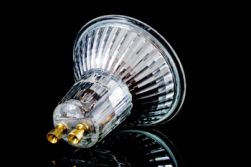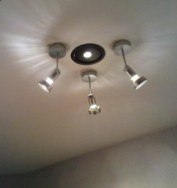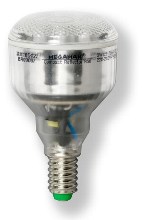Categories: Electrician at home, Sources of light
Number of views: 124082
Comments on the article: 5
How to choose a bulb for recessed spotlights
 Range recessed spotlights Today it can satisfy, perhaps, any, even the most demanding customer. Not the last role when choosing fixtures is played by bulbs installed in fixtures.
Range recessed spotlights Today it can satisfy, perhaps, any, even the most demanding customer. Not the last role when choosing fixtures is played by bulbs installed in fixtures.
Just a couple of years ago, there were only two types of bulbs for recessed downlights halogen and incandescent. We will not dwell on the description of the variety of halogen lamps. The purpose of the article is slightly different - to show the advantages and disadvantages of various types of lamps.
The principle of operation in both lamps is approximately the same. The only difference is the gas with which the bulbs are filled. We will not dwell on the technical subtleties, we only note that the service life of the “halogen” is 1.5-2 times longer than that of ordinary incandescent lamps, and the light spectrum, depending on the filling of the bulb, is slightly different.
 The disadvantage of halogen bulbs is their high temperature. Everyone who is even a little familiar with incandescent lamps knows that the efficiency of the “halogen” and incandescent lamps is extremely low. About 70-80% of the energy goes to heating, and only 15-20% to the light. It turns out that we use lamps more for heating than for lighting. Due to the high temperature and because of the unimportant quality of the components of the fixtures, often the reason for the failure of the lamp itself is the quality of the base.
The disadvantage of halogen bulbs is their high temperature. Everyone who is even a little familiar with incandescent lamps knows that the efficiency of the “halogen” and incandescent lamps is extremely low. About 70-80% of the energy goes to heating, and only 15-20% to the light. It turns out that we use lamps more for heating than for lighting. Due to the high temperature and because of the unimportant quality of the components of the fixtures, often the reason for the failure of the lamp itself is the quality of the base.
To date, these two types of lamps remain, perhaps, the most popular. Some people buy these bulbs out of habit, many are satisfied with their price-quality ratio. And the assortment of lamps presented is quite large. Lamps of various colors are available, for all types of socles-G4, G5, G9, etc. Well, there are some buyers who simply don’t know that for several years now a worthy alternative to “halogen” and incandescent bulbs has appeared.
 What kind of alternative is this? Many have seen, but someone has already begun to change ordinary incandescent bulbs to the so-called "Housekeepers". "Housekeepers" are issued under standard cap (threaded part of the bulb) - E27 (large base) and E14 (minions). There is also under E40, but these are already quite powerful lamps, almost no one uses them in everyday life. So, recently launched the production of economy - lamps MR-16 under the G5 base, for installation in recessed spotlights.
What kind of alternative is this? Many have seen, but someone has already begun to change ordinary incandescent bulbs to the so-called "Housekeepers". "Housekeepers" are issued under standard cap (threaded part of the bulb) - E27 (large base) and E14 (minions). There is also under E40, but these are already quite powerful lamps, almost no one uses them in everyday life. So, recently launched the production of economy - lamps MR-16 under the G5 base, for installation in recessed spotlights.
The main advantage of the “housekeepers” is: economy - 5-6 times less energy consumption than the “halogen”, low temperature - 50-70 degrees, which allows them to be installed on plastic ceilings, mounted in suspended ceilings. It is this type of lamp that manufacturers of suspended ceilings recommend.
At the moment, housekeepers are released with a spectrum of light of only three types: warm (yellow), daytime and cold (closer to blue-blue). According to the power of an economy lamp, standard MR-16 are from 2-3 watts to 11-15 watts. "Halogens" require about 4-6 times more energy in order to give as much light. The service life of the “halogen” is on average 1000-1500 hours, the service life of the “housekeepers” is 3-7 times longer and, according to the manufacturers, can reach up to 10,000 hours, which also must be taken into account when choosing bulbs.
 One of the key points for the normal operation of halogen lamps is a stable voltage. "Halogens" are very sensitive to voltage drops. An increase in the nominal voltage by only 5% leads to a reduction in service life to 40%. A voltage reduction of 5% reduces the light output of the lamps by up to 20%.
One of the key points for the normal operation of halogen lamps is a stable voltage. "Halogens" are very sensitive to voltage drops. An increase in the nominal voltage by only 5% leads to a reduction in service life to 40%. A voltage reduction of 5% reduces the light output of the lamps by up to 20%.
To extend the service life, various additional devices are used. For halogen lamps with a voltage of 220 V, soft starters are used. The fact is that most lamps burn out when turned on.This is due to the fact that in the cold state, the resistance of the filament of the lamp is several times less than in the heated one. Accordingly, the current passing through the filament is 10 times more. For a 100 W lamp, for example, this current can reach up to 3-6 A. But this is already a technical subtlety.
So, this very soft starter gradually, within 0.5-2 sec., Brings the voltage to the nominal. It is recommended to install such devices on each lamp individually or on a group of lamps, if the power of the device allows.
In addition to halogen lamps designed for a voltage of 220 V, there are also halogen lamps designed for a voltage of 12 V. But in order to use them in a 220V network, a step-down transformer is needed.
 Modern step-down transformers, these are 2-in-1 devices. This is both a transformer and a soft starter. In more detail on this device, we will stop in the next article. We only note that the use of high-quality transformers significantly increases the lamp life.
Modern step-down transformers, these are 2-in-1 devices. This is both a transformer and a soft starter. In more detail on this device, we will stop in the next article. We only note that the use of high-quality transformers significantly increases the lamp life.
The next applicant to take the place of halogen and incandescent lamps can be safely called LED bulbs. The indisputable advantage of these fixtures is their durability - up to 50,000 hours, scanty electricity consumption.
For example, a lamp assembled using LEDs, when consuming only 3.5 W, gives as much light as a 35 W halogen lamp, as they say, does not need comments. Today, a variety of LED lamps can satisfy the needs of any consumer, but, unfortunately, the range presented in our market for ordinary consumers is still relatively scarce.
The disadvantages of LED lamps are their relatively high cost, but it is getting lower every day. Today, the cost of LED bulbs can be compared with the price of high-quality “housekeepers”.
See also on this topic (new data for 2016): Comparison of the power of various types of lamps
Sergey Seromashenko
See also at bgv.electricianexp.com
:
